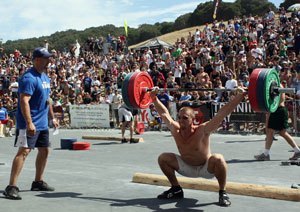5 Steps To Prepare For CrossFit To Prevent Injury
 There’s been numerous news stories of cross fit causing physical injuries. Heck YouTube is full of videos depicting the opposite of correct form with Cross Fit “athletes”. What are the pros and cons of CrossFit and how can one physically prepare themselves to avoid injury and risking being out of it for a long time?
There’s been numerous news stories of cross fit causing physical injuries. Heck YouTube is full of videos depicting the opposite of correct form with Cross Fit “athletes”. What are the pros and cons of CrossFit and how can one physically prepare themselves to avoid injury and risking being out of it for a long time?
There are quite a few pros of CrossFit:
a) It’s great for conditioning and pushing yourself to your limits and breaking through them (when done at the level that matches your current abilities)
b) It’s fun! What else is there to say? Throwing weights around and beating your previous best is always a good time.
c) It has an excellent support network. Your peers will cheer you on and support you
d) It uses compound movements (what our bodies were meant to do) working the body through a full range of motion
e) It consistently varies the skilled movements, eliminating boredom and adaptation
The main cons are:
a) Insufficient assessment of the athlete’s abilities. Some trainers are great about this, they have a set number of 1 on 1 sessions which new members must perform before they can join a class
b) Members wanting to increase their intensity before their skill levels are sufficient – so this comes down to good trainers doing their due diligence in prescribing exercises toat match a trainee’s skill level
c) The exercises are explosive and require high level skills, creating a steeper learning curve
d) One size fits all methodology (except for some trainers who do take past injuries, health histories and skill levels into consideration)
Now, let me get to the point of this post. Here are some steps you can take to prepare your body for the highly skilled, power movements that CrossFit uses:
Know where you’re at:
1) Get a full musculoskeletal assessment done – this will correctly arm you with the information about where you stand right now. What your dominant muscles are, what muscles or muscle groups are “sleeping” or “lazy”, what compensates, whether your lumbar, thoracic and cervical spines have the needed range of motion in all three planes to be able to perform explosive movements. This will give you a snapshot of your current abilities and a starting point for what type of corrective exercises you’ll need to be able to perform at your maximal level.
2) Get a postural assessment done – Knowing if your body is aligned correctly will save you endless hours in the gym (it will also save you from pain.) The body has great adaptability and will compensate for sub optimal posture by favouring dominant muscles thereby increasing the severity of the imbalance over time. This is totally under the radar with every day activities. The real problem of an out of balance body begins when you start loading it with weight and complex movement patterns. It compounds when you add high speed, explosive power moves for high repetitions, under fatigue. Sounds like CrossFit matches all of those.
3) Get a movement pattern assessment done – Being able to squat, lunge, bend and so on is great, being able to do all those at the optimal level is where weekend warriors get separated from high level athletes. When you’re loading the bar, hoisting heavy weights overhead, the last thing you want to worry about is dominant quads, unstable pelvis or tight ankles. All of which are indicators of an injury waiting to happen (unless they’re corrected.)
4) Get your nutrition and lifestyle assessed – Since every cell in our body is generated from the foods we eat, our hormone levels are greatly affected by our lifestyle, it would make sense to have a baseline of both our nutrition and lifestyle. In order to recuperate fastest from any type of exercise, we must optimally nourish ourselves. When you work out, you break down muscle tissue. Your body needs protein to repair and regenerate your muscle tissue. It needs high quality fats to regulate hormones (which in turn affect your mood and energy levels.) Carbohydrates are also needed for energy but how much depends greatly on the individual. There are also food sensitivities that might hinder your performance and ability to safely do certain movements. All of this needs to be taken into consideration before you begin CrossFit workouts to prevent possibilities of injuring yourself and being out of the gym for months.
Prepare your body by making it injury proof:
5) Address the imbalances found in the above 4 points, by adhering to a corrective program (4 – 6 weeks depending on findings) that addresses the imbalances, strengthens you, gets you into optimal movement patterns and arms you with nutrition and lifestyle habits you can count on to save you from hurting yourself.
Without taking care of the foundation and thoroughly assessing your current physical abilities, lifestyle and nutrition, you and your CrossFit coach are, at best, guessing what to do. We are all built differently and have different abilities and skill levels, keep that in mind before performing what everyone else is doing.
Have you ever been injured exercises? How long were you out for and what did you do to rehabilitate yourself?

